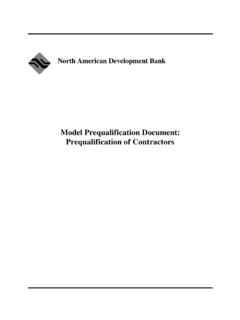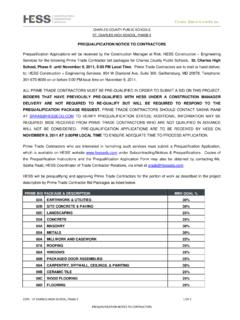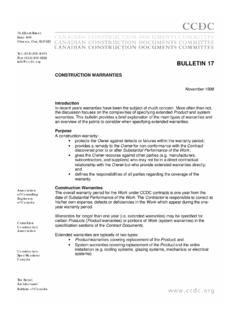Transcription of 44 appendix final - fullertonlaw.com
1 appendix 44 | Construction Law Survival Manual | | James D. Fullerton, Esq. 609 Construction Bonds on Public Projects (Reprinted with permission from NACM s Manual of Credit and Commercial Laws, 104th edition) What is a construction surety bond? A bond is a contract or a guarantee agreement which contains the promise of a third party, a bonding company or surety, to pay a fixed sum if certain acts are not performed. The acts are typically non-performance or non-payment. A surety bond is not an insurance policy. Rather, a surety bond is a guarantee, in which the surety guarantees that the contractor, called the principal in the bond, will perform the obligation stated in the bond. For example, the obligation stated in a bid bond is that the principal will honor its bid; the obligation in a performance bond is that the principal will complete the project; and the obligation in a payment bond is that the principal will pay subcontractors and suppliers.
2 Bonds frequently state, as a condition, that if the principal fully performs the stated obligation, then the bond is void; otherwise, the bond remains in full force and effect. If the principal fails to perform the obligation stated in the bond, both the principal and the surety are liable on the bond. That is, either the principal or surety or both may be sued on the bond, and the entire liability may be collected from either the principal or the surety. The amount in which a bond is issued is the penal sum the highest limit of liability of the bond. The person or firm to whom the principal and surety owe their obligation is called the obligee. On bid bonds, performance bonds and payment bonds, the obligee is usually the owner. Where a subcontractor furnishes a bond, however, the obligee may be the owner or the prime contractor or both. The people or companies who are entitled to sue on a bond, sometimes called beneficiaries, are usually but not necessarily named in the bond.
3 In a payment bond, many of the beneficiaries are not yet contracted-with at the time the bond is issued. Fortunately, those yet-to-be-determined beneficiaries are usually defined in the language of the bond by position on the ladder of supply or in state and federal statutes that require bonds on public projects. While varying types of security have a long history, it wasn t until the 19th century that corporate surety bonds were used. Recognizing the need to protect taxpayers from contractor failure, Congress passed the Heard Act on August 13, 1894. The Heard Act required surety bonds on all federally funded projects. During the New Deal, the federal government initiated massive public construction projects. Problems arose when subcontractors and suppliers went unpaid because of defaulting or unscrupulous general contractors working with government agencies. Attempts by suppliers to protect their rights under lien laws ran contrary to the principle of sovereign immunity granted to the United States.
4 In 1935, Congress passed the Miller Act, which completely eliminated the right of a subcontractor or supplier to impose any form of mechanic s lien or other encumbrance against federal public works projects. The primary purpose of the Miller Act, however, was to protect subcontractors who supplied material and labor to federal public works projects by providing an alternative, and usually superior, remedy to the assertion of mechanic s liens. Under the Miller Act, a payment bond must be provided by the principal or general contractor on every federal contract to protect the right of payment for those supplying materials or services to the federal project. With few exceptions, which are not pertinent here, all federal public construction projects are subject to the provisions of the Miller Act. In the states, suppliers encountered some of the same difficulties with state, county, municipal and other local projects that originally created the need for the Miller Act.
5 Where payments by the general contractor were not made, state and local authorities which owned the project sought to insulate themselves from mechanic s liens by suppliers and subcontractors as the federal government had. Early efforts by states to declare sovereign immunity to eliminate a mechanic s lien were met with constitutional challenges. Following the success of the Miller Act for federal projects, the states then began enacting what came to be known as Little Miller Acts. These Little Miller Acts are modeled after the federal Miller Act, and state courts have generally held that the Little Miller Acts are to be interpreted in conformity with the federal statute. The Little Miller Acts also require the principal or general contractor to post a payment bond as a condition of awarding the contract. This payment bond takes the place of any right of a supplier or subcontractor to assert a mechanic s or other type of lien. Since the substantive rights of the suppliers and subcontractors were not being adversely affected and, in fact, in many instances were being enhanced, public policy and constitutional protections permitted the elimination of the right to claim a mechanic s lien on state and municipally funded public projects.
6 Since each state s statute is somewhat different, suppliers and subcontractors attempting to rely on the provisions of the state legislation should be careful to understand any unique or particular provisions contained in a particular state s law. James D. Fullerton, Esq. | | Construction Law Survival Manual | appendix 44 610 PRIVATE BONDS AND PERFORMANCE BONDS Although surety bonds are required by law on most public projects, the use of bonds on privately owned projects is up to each owner. With bonds, the risks of project completion are shifted from the owner to the surety company. For that reason, many private owners require surety bonds from their contractors to protect their company, lenders and shareholders from the cost of contractor failure. For suppliers and subcontractors, it is important to ask your customer, the prime contractor and the owner if a private project is bonded. To bond a project, the owner specifies the bonding requirements in the contract documents.
7 Obtaining bonds and delivering them to the owner is usually the responsibility of the prime contractor, who will consult with a surety bond producer. Subcontractors may also be required to obtain surety bonds to help the prime contractor manage risk, especially when the subcontractor is a significant part of the job. Most surety companies are subsidiaries or divisions of large insurance companies and are regulated by state insurance departments. The surety prequalifies the contractor based on financial strength and construction expertise. Since the bond is underwritten with little expectation of loss, the premium is primarily a fee for prequalification services, although sureties also use industry-wide loss costs and loss studies to determine premiums. The Miller Act and the state statutes discussed in this chapter address bonds taken to assure payment to suppliers and materialmen.
8 Many states also have statutes requiring performance bonds. A performance bond guarantees the owner that the principal will complete the contract according to its terms, including price and time. The owner is the obligee of a performance bond and may sue the principal and the surety on the bond. If the principal defaults or is terminated for default by the owner, the owner may call upon the surety to complete the contract. Many performance bonds give the surety three choices: completing the contract itself through a completion contractor; selecting a new contractor to contract directly with the owner; or allowing the owner to complete the work with the surety paying the costs. The penal sum of the performance bond usually is the amount of the prime construction contract, and often is increased when change orders are issued. When payment bonds have been made available for a particular project, whether governmental or private, the owner is able to substitute the right to assert a mechanic s lien with the right to make a claim against the bond.
9 It is always valuable to know, as a credit grantor, whether there are bonds on a construction project. The terms of the bond can materially affect (positively or negatively) the supplier s rights with respect to payment. It must be remembered that bonds are obligations of third parties not related to the debtor-creditor relationship that exists. A bond is additional security, like having a third-party guarantee, but like a guarantee, it has conditions which must be met to obtain the payment protections granted. In private bond projects, and frequently on public bond projects, the creditor, as a third-party beneficiary, is bound by the terms of the contract created by the bond, even though the creditor is not a party to this contract. Therefore, it is very important that credit grantors not rely on generalities or oral representations when dealing with bonds, but rather review the actual terms of the bonds to make sure that any reliance is justified, and that any compliance is strictly in accordance with the terms of the agreement.
10 Payment bonds may have provisions limiting the time in which a claim may be asserted. They may also have additional restrictive periods during which litigation may be filed and prosecuted. Again, it is important that if a credit grantor intends to rely on a payment bond, a copy of the bond should be obtained. Careful attention should be paid to the requirements for giving notice, the type of notice, the documentation to be presented and other time limitations, including the limitation period by which litigation must be commenced. Suppliers and subcontractors should also attempt to secure a copy of the payment bond during the process of negotiating the underlying contract or as soon as possible thereafter. There are three critical reasons to get copies of bonds up front. First, to be assured the bond exists; second, to determine if the surety has the necessary assets in the event of failure; and, third, because the bond contains the rules to the game.






